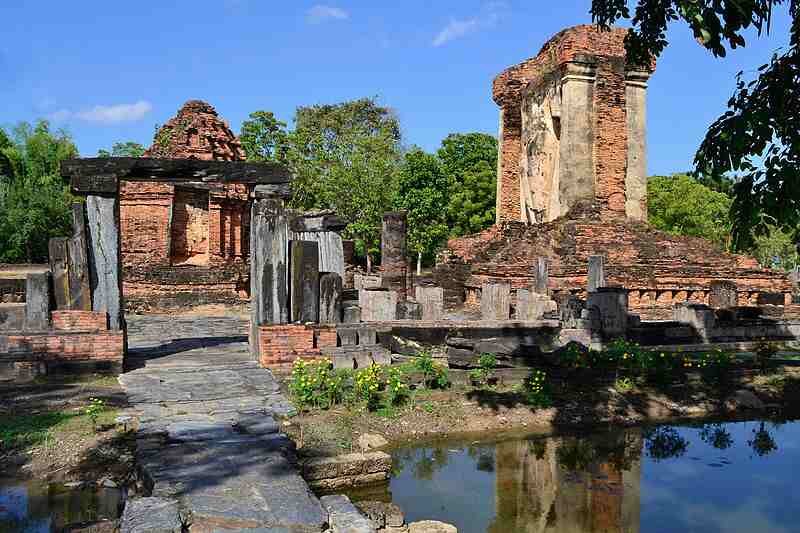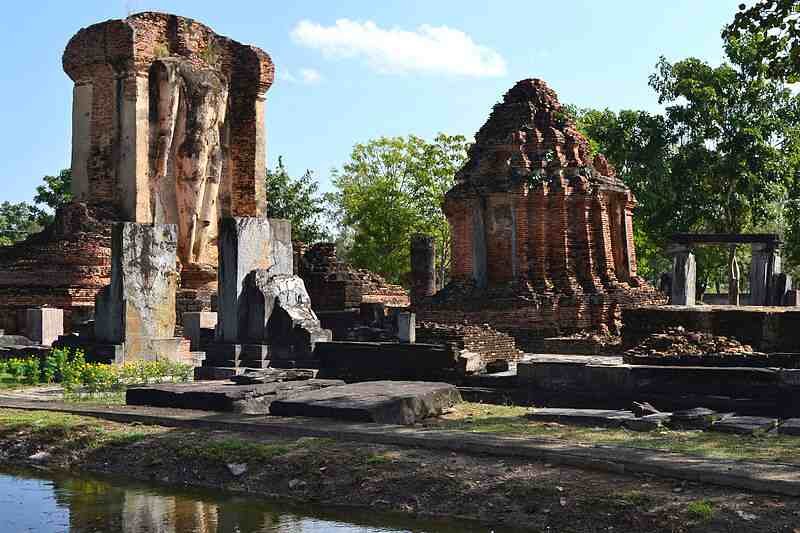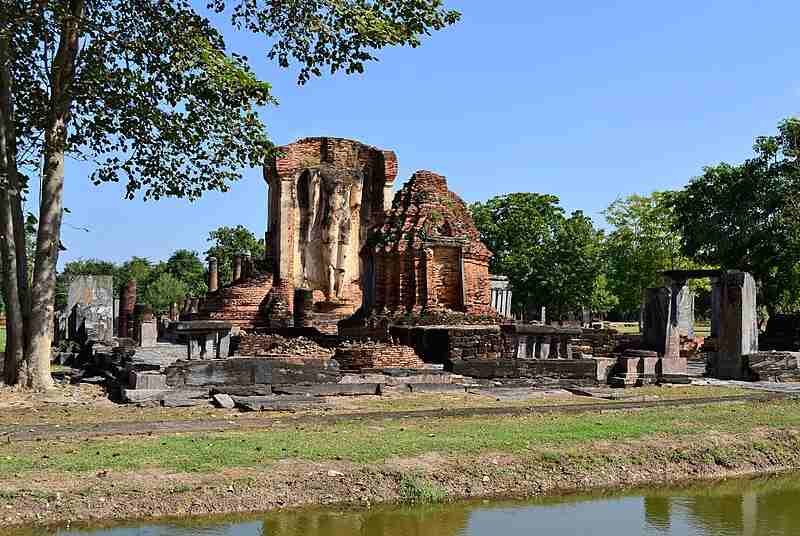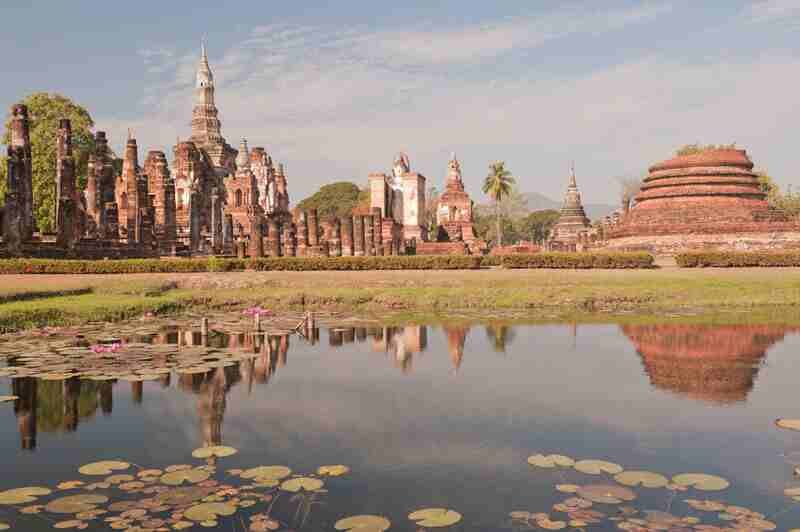Wat Chetuphon is a remarkable temple located in the historical province of Sukhothai, Thailand. This ancient site, rich in history and architectural beauty, is an essential part of the Sukhothai Historical Park, a UNESCO World Heritage Site.
In this post, we will delve into the history, architecture, and significance of Wat Chetuphon, providing you with all the information you need to appreciate this remarkable site.

The History of Wat Chetuphon
Wat Chetuphon was constructed during the late 13th century, a period marked by the flourishing of the Sukhothai Kingdom under King Ramkhamhaeng.
This era is often regarded as a golden age for Thai culture and Buddhism. The temple is situated approximately two kilometers south of the southern city wall of Sukhothai, making it one of the most prominent temples in the region.
The temple’s name, Chetuphon, translates to “the temple of the seven relics,” indicating its importance as a spiritual center.
Although there is no principal chedi—a common feature in many temples—the main mandapa enshrines four large Buddha images in different postures: walking, standing, sitting, and reclining.
This unique arrangement signifies various aspects of Buddhist teachings and meditation practices.
A stone inscription found at Wat Chetuphon mentions an event from 1514 involving the construction of a Buddha image, highlighting its continued significance even centuries after its establishment.
The temple is also referenced in inscriptions from other nearby temples, indicating its role as a hub for religious discussions among monks during the late Sukhothai period.
The Significance of the Four Buddhas
The four Buddha images of Wat Chetuphon each hold profound religious significance. The standing Buddha represents the Buddha teaching his first disciples after achieving enlightenment.
The seated Buddha signifies meditation and is a common image in Thai temples. The walking Buddha, less common but equally powerful, symbolizes the Buddha spreading his teachings, while the reclining Buddha depicts the moment of his passing into Nirvana.
These representations reflect key moments in the Buddha’s life and provide an educational experience for those unfamiliar with these symbols.

The Evolution of Wat Chetuphon: From Ancient Glory to Present Day
Wat Chetuphon, located in the Sukhothai Historical Park, is a temple that has witnessed centuries of history, transformation, and cultural significance.
Understanding how this temple was in its prime compared to its current state provides insight into the rich heritage of Thailand.
The Temple’s Past
Architectural Grandeur
Originally, Wat Chetuphon was a grand religious site built during the late 13th century, likely under the reign of King Ramkhamhaeng. The temple was designed as a significant center for Buddhist worship and learning. Its architectural features included:
Main Mandapa: The most striking element was the mandapa that housed four large Buddha images in various postures: walking, standing, sitting, and reclining. Each image faced a different direction, symbolizing the Buddha’s omnipresence.
Surrounding Structures: Adjacent to the mandapa were smaller mandapas and a large viharn (assembly hall), surrounded by several chedis. These structures were adorned with intricate carvings and served as gathering places for monks and worshippers.
Slate Wall: A unique feature of Wat Chetuphon was its surrounding wall made from large slate slabs, giving it a wooden appearance. This design not only enhanced its aesthetic appeal but also provided a sense of enclosure and sanctity.
Cultural Significance
In its heyday, Wat Chetuphon was not just a temple but a vibrant community hub where monks gathered to discuss religious matters and share teachings.
It played a pivotal role in the spread of Theravada Buddhism throughout the region. Historical inscriptions suggest that it was an important site for Buddhist ceremonies and festivals.
Current State: Wat Chetuphon Today
Architectural Remnants
Today, Wat Chetuphon stands as a testament to its storied past, albeit in a state of partial ruin:
Mandapa Condition: The main mandapa still exists but has suffered significant damage over time. The roof that once sheltered the Buddha images has collapsed, and while some images remain, they are incomplete—most notably, the heads of both the standing and walking Buddhas are missing.
Surrounding Structures: The smaller mandapas and viharn still show signs of their former glory. The high bases and several large pillars remain intact, although they now bear the scars of weathering and time.
Slate Wall: Parts of the slate wall are still standing, serving as a reminder of the temple’s original design. However, erosion and neglect have taken their toll on this unique feature.
Preservation Efforts
Despite its dilapidated state, efforts have been made to preserve Wat Chetuphon as part of the Sukhothai Historical Park.
The site is maintained by Thailand’s Fine Arts Department, which works to protect its historical integrity while allowing visitors to experience its cultural significance.
Visitor Experience
Today, Wat Chetuphon attracts tourists and pilgrims alike who come to marvel at its historical architecture and reflect on its spiritual legacy. Visitors can explore:
Guided Tours: Many choose guided tours that provide insights into the temple’s history and significance within the context of Sukhothai’s broader historical narrative.
Cultural Events: Occasionally, cultural events or ceremonies are held at the site, allowing visitors to witness traditional practices that connect modern worshippers with their ancient roots.
In summary, The transformation of Wat Chetuphon from an active center of Buddhist worship to a historical site reflects both the passage of time and the enduring legacy of Thai culture.
While much has changed since its inception in the 13th century, the temple remains an essential part of Sukhothai’s historical landscape.
By visiting Wat Chetuphon today, one can appreciate not only its architectural beauty but also its rich history—a bridge connecting past spiritual practices with contemporary reverence for Thailand’s cultural heritage.

Exploring the Surrounding Area of Wat Chetuphon
Wat Chetuphon is part of the expansive Sukhothai Historical Park, a UNESCO World Heritage Site that preserves the ruins of the ancient city of Sukhothai.
The park is divided into five zones: central, north, south, east, and west. Wat Chetuphon is located in the southwestern zone, away from the more crowded areas, making it a hidden treasure for those willing to venture beyond the main tourist attractions.
Sukhothai Historical Park Zones
1. Central Zone:
This is the heart of the park and includes some of the most significant and well-preserved ruins. Key attractions here include:
Wat Mahathat: The largest and most important temple in the park, known for its impressive central chedi and numerous Buddha statues. It served as the spiritual center of the Sukhothai Kingdom.
Wat Si Sawai: This temple displays clear influences of Hindu architecture, with its three prangs (towers) reminiscent of Khmer-style temples. It was originally a Hindu temple before being converted to a Buddhist one.
Ramkhamhaeng National Museum: Located nearby, this museum offers a comprehensive collection of artifacts from the Sukhothai period, providing valuable insights into the history and culture of the era.
2. Northern Zone:
This area is known for its serene atmosphere and significant historical sites, including:
Wat Phra Phai Luang: One of the largest temples in Sukhothai, it features a large prang and several Buddha images. It is believed to have been an important religious center before the establishment of Wat Mahathat.
Wat Si Chum: Famous for its massive seated Buddha image, which is one of the most iconic sights in Sukhothai. The Buddha is housed in a mondop with narrow openings, creating a dramatic and awe-inspiring view.
3. Southern Zone:
This zone includes several lesser-known but equally fascinating temples, such as:
Wat Chetuphon: Known for its unique architectural features and the four-sided mondop housing Buddha statues in four classic poses. It offers a peaceful retreat away from the busier central zone.
Wat Chedi Si Hong: A smaller temple known for its well-preserved stucco reliefs depicting scenes from the life of the Buddha.
4. Eastern Zone:
This area is less frequented by tourists but contains some interesting ruins, including:
Wat Chang Lom: Notable for its large bell-shaped chedi surrounded by elephant statues, symbolizing the strength and stability of the Sukhothai Kingdom.
Wat Traphang Thong: Located on an island in a large pond, this temple is accessible via a wooden bridge and offers a picturesque setting.
5. Western Zone:
This zone is characterized by its hilly terrain and scenic views, featuring:
Wat Saphan Hin: Situated on a hill, this temple offers panoramic views of the surrounding area and features a large standing Buddha image. It is a popular spot for sunrise and sunset views.
Wat Aranyik: A smaller temple known for its peaceful ambiance and beautiful surroundings.
In summary, Exploring the surrounding area of Wat Chetuphon within the Sukhothai Historical Park offers a rich and immersive experience into Thailand’s ancient history and cultural heritage.
Each zone within the park presents unique architectural marvels and historical insights, making it a must-visit destination for history enthusiasts and travelers alike.

♣♣ To learn more about Sukhothai and Sukhothai Historical Park, make sure to check out our amazing post.⇒ Tremendous Sukhothai, Thailand: A Rich Historic Hub
You May Also Like: ⇓
- Fascinating Wat Saphan Hin: A Hilltop Haven in Sukhothai
- Daring Wat Si Chum: The Surprising Temple of Sukhothai
- Attractive Wat Traphang Ngoen: The Jewel of Sukhothai
- Beautiful Wat Sa Si: A Gem in Sukhothai Historical Park
Conclusion
Wat Chetuphon, nestled within the serene and historically rich Sukhothai Historical Park, is a hidden gem that offers a profound glimpse into Thailand’s ancient past.
Its unique architectural features, intriguing legends, and tranquil ambiance make it a must-visit destination for those seeking to explore the spiritual and cultural heritage of the Sukhothai kingdom.
As you wander through the temple grounds and the surrounding historical park, you’ll be transported back in time, experiencing the grandeur and serenity that once defined this ancient city.
The blend of historical significance, architectural beauty, and peaceful surroundings ensures that your visit will be both enlightening and memorable.
So, venture beyond the main tourist paths and discover the timeless treasures of Wat Chetuphon and the Sukhothai Historical Park, where history and spirituality come alive in the heart of Thailand.